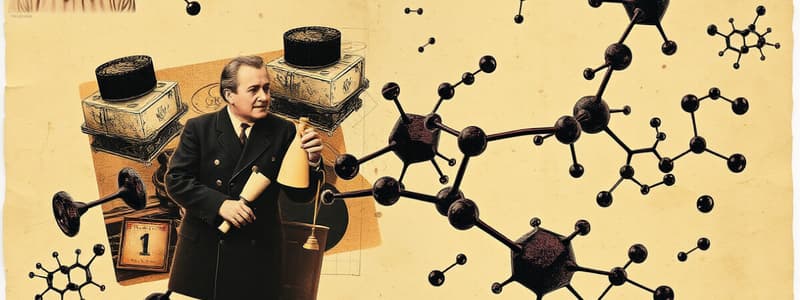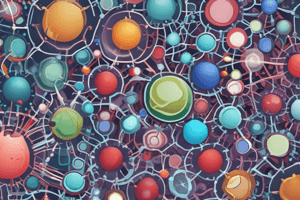Podcast
Questions and Answers
What does the term 'tetravalent' refer to in relation to carbon?
What does the term 'tetravalent' refer to in relation to carbon?
- It can only form double bonds.
- It reacts exclusively with noble gases.
- It can form four bonds with other atoms. (correct)
- It has a full outer electron shell.
Which of the following accurately describes an ionic bond?
Which of the following accurately describes an ionic bond?
- It involves the sharing of electrons between atoms.
- It leads to the formation of charged ions. (correct)
- It requires a liquid medium to occur.
- It is only found in organic compounds.
What type of bond results from the sharing of electrons between two atoms?
What type of bond results from the sharing of electrons between two atoms?
- Hydrogen bond
- Ionic bond
- Metallic bond
- Covalent bond (correct)
Which statement is true about polar covalent bonds?
Which statement is true about polar covalent bonds?
What factors influence the solubility of a molecule in a solvent?
What factors influence the solubility of a molecule in a solvent?
Which of the following groups primarily forms negatively charged ions?
Which of the following groups primarily forms negatively charged ions?
What characterizes a nonpolar molecule?
What characterizes a nonpolar molecule?
Which type of intermolecular force is primarily responsible for the physical properties of substances?
Which type of intermolecular force is primarily responsible for the physical properties of substances?
What is the primary process by which cells link monomers to form polymers?
What is the primary process by which cells link monomers to form polymers?
Which of the following best describes the process of breaking down macromolecules?
Which of the following best describes the process of breaking down macromolecules?
What is the common theme regarding monomers and polymers as mentioned in the document?
What is the common theme regarding monomers and polymers as mentioned in the document?
In the dehydration synthesis process, what is removed during the reaction?
In the dehydration synthesis process, what is removed during the reaction?
Which biomolecule is synthesized predominantly via dehydration synthesis?
Which biomolecule is synthesized predominantly via dehydration synthesis?
What distinguishes skeletal isomerism from other types of isomerism?
What distinguishes skeletal isomerism from other types of isomerism?
Which type of isomerism involves different positions of functional groups?
Which type of isomerism involves different positions of functional groups?
What is a key characteristic of stereoisomerism?
What is a key characteristic of stereoisomerism?
What concept suggests that biochemicals can only be produced by living organisms?
What concept suggests that biochemicals can only be produced by living organisms?
What type of functional groups are considered in the concept of functional isomerism?
What type of functional groups are considered in the concept of functional isomerism?
Which statement best describes trans-functional groups?
Which statement best describes trans-functional groups?
What does the term 'bioconversion' refer to?
What does the term 'bioconversion' refer to?
What significant event is marked by the synthesis of urea in 1828?
What significant event is marked by the synthesis of urea in 1828?
What characterizes the difference between enantiomers?
What characterizes the difference between enantiomers?
What type of rotation is indicated when a molecule rotates to the right?
What type of rotation is indicated when a molecule rotates to the right?
Which of the following describes diastereomers?
Which of the following describes diastereomers?
In the context of macromolecules, which is NOT considered a biomolecule?
In the context of macromolecules, which is NOT considered a biomolecule?
What describes the 'cis' configuration in organic compounds?
What describes the 'cis' configuration in organic compounds?
Which statement is true concerning the synthesis of organic compounds from inorganic substances?
Which statement is true concerning the synthesis of organic compounds from inorganic substances?
Which term describes a structure composed of macromolecules, like proteins or nucleic acids, working together?
Which term describes a structure composed of macromolecules, like proteins or nucleic acids, working together?
What is the fundamental difference between 'delect' and 'levo' in the context of molecular rotation?
What is the fundamental difference between 'delect' and 'levo' in the context of molecular rotation?
What type of bond is characterized by an asymmetrical distribution of electron density?
What type of bond is characterized by an asymmetrical distribution of electron density?
What determines the bond polarity in covalent bonds?
What determines the bond polarity in covalent bonds?
Which of the following describes a nonpolar covalent bond?
Which of the following describes a nonpolar covalent bond?
What is the relationship between electronegativity and polar covalent bonds?
What is the relationship between electronegativity and polar covalent bonds?
In the context of biomolecules, which of the following is primarily studied under biochemistry?
In the context of biomolecules, which of the following is primarily studied under biochemistry?
Which type of bond is NOT a characteristic of substances with similar electronegativities?
Which type of bond is NOT a characteristic of substances with similar electronegativities?
What primarily influences the strength and characteristics of polar covalent bonds?
What primarily influences the strength and characteristics of polar covalent bonds?
Which process is NOT part of the central dogma of molecular biology?
Which process is NOT part of the central dogma of molecular biology?
Flashcards are hidden until you start studying
Study Notes
Molecules and Compounds
- Molecules form when two or more atoms unite based on electron structure.
- Carbon is in Period 2, Group IV of the Periodic Table and is tetravalent.
- Carbon's structure allows it to participate in various chemical reactions and form numerous compounds.
Types of Chemical Bonds
- Ionic Bond: Involves the complete transfer of electrons, creating charged ions.
- Covalent Bond: Results from the sharing of electrons; can be polar (unequal sharing) or nonpolar (equal sharing).
Bond Polarity and Electronegativity
- Polar covalent bonds arise from differences in electronegativity, affecting electron distribution.
- Polar and nonpolar bonds are determined by the difference in electronegativities of participating atoms.
Intermolecular Forces of Attraction
- Physical properties of substances are influenced by intermolecular forces of attraction (IMFA).
- Types of IMFA significantly affect states of matter and solubility.
Isomerism
- Structural Isomerism: Different bonding arrangements of atoms.
- Skeletal Isomerism: Different carbon skeletons.
- Positional Isomerism: Different positions of functional groups on the same carbon skeleton.
- Functional Group Isomerism: Different functional groups (e.g., alcohol vs. ether).
- Stereoisomerism: Same molecular formula but different orientations in space.
- Geometric Isomerism: Orientation around a double bond.
- Optical Isomerism: Enantiomers (mirror images) and diastereomers (non-mirror images) based on spatial arrangement.
Origins of Life
- Vitalism proposes that living organisms function under different principles than inorganic substances.
- Evidence of biochemical synthesis from inorganic compounds (Friedrich Wohler's synthesis of urea) shows that biologically relevant compounds can be created through chemical processes.
Biomolecules
- Consist of macromolecules formed from monomers through dehydration synthesis (removal of water).
- Categories of biomolecules:
- Carbohydrates: Sugars and starches functioning in energy storage and supply.
- Proteins: Composed of amino acids and crucial for structure and function in cells.
- Lipids: Fatty acids and their derivatives, significant in energy storage and cellular structure.
- Nucleic Acids: DNA and RNA, vital for genetic information storage and transfer.
Common Theme in Biomolecule Formation
- Monomers combine to form polymers through condensation reactions and are separated by hydrolysis reactions, where water is added to break bonds.
Studying That Suits You
Use AI to generate personalized quizzes and flashcards to suit your learning preferences.




